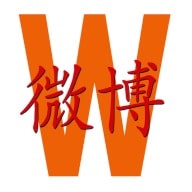China Insight
‘Divorce Day’: Queuing Up to Get Divorced after Chinese Spring Festival Holiday
The first day after the Spring Festival holiday is a busy one at the Bureau of Civil Affairs as couples are lining up to register a divorce.
Published
2 years agoon
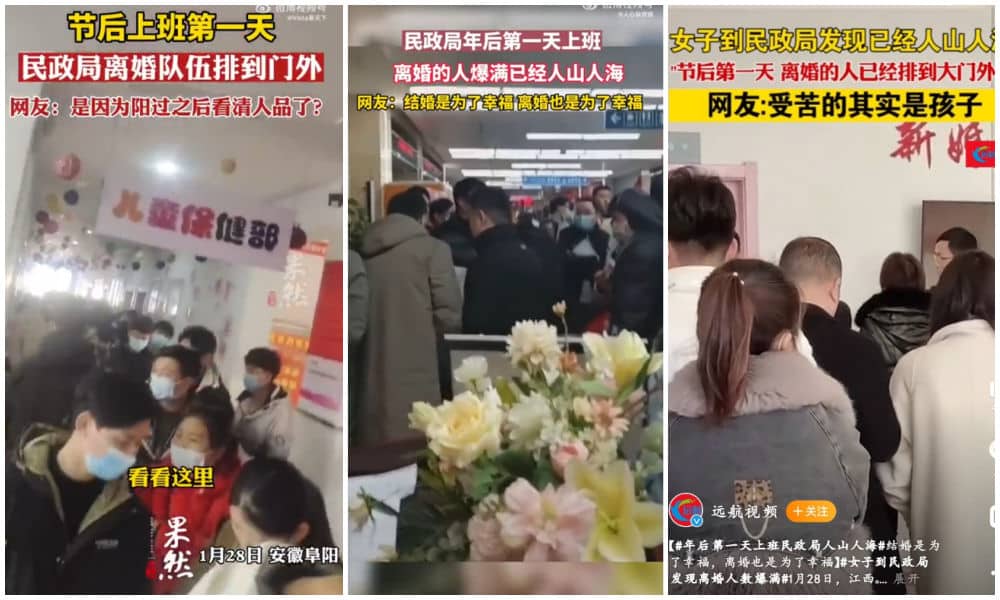
On the first day after the Chinese Spring Festival holiday (Jan. 21-27), there are long lines at the Civil Affairs Bureau in several places across China.
In Jiangxi, one resident shared how couples were queuing up to file for divorce on the first day the local Bureau of Civil Affairs reopened its doors. The lines were allegedly so long that people had to wait outside. Another video showed similar scenes at a local bureau in Anhui province. A third video showed crowded scenes of people lining up to register a divorce in Henan.
Chinese media accounts such as Toutiao News (@头条新闻), Vista (@Vista看天下), and Phoenix News (@凤凰周刊) all posted about the long divorce lines on Jan. 29, with one post about the topic receiving 70,000 likes.
“I thought they were lining up to get married, then I watched the news and saw they were actually lining up to get divorced..,” one commenter wrote. Others wondered if the busy lines for the divorce registration office might have something to do with the Covid outbreak over the past weeks, with some couples finding out that their partner actually is not very sympathetic when they are sick (also read this article).
The Chinese media outlets posting about the divorce registration lines mentioned how the ones who suffer the most in a divorce are the children, but many commenters did not agree with this statement, arguing that children suffer the most when parents stay together for the sake of the children and then continue fighting.
The divorce trend after the Chinese Lunar New Year has also been discussed in Chinese media and on social media in previous years (“春节后离婚潮”).
In Western countries, it is a known fact that divorce rates increase after Christmas time; the Monday after Christmas break is also dubbed “Divorce Day.” Some sources claim this is often due to quarrels that occur during Christmas and the financial pressures that come with the festive season.
It is arguably not much different for the Chinese New Year, when incidents taking place during family gatherings could be the straw that broke the camel’s back.
“The Spring Festival is like a big marriage minefield,” one commenter wrote: “When you return to your family home, it doesn’t just mean reuniting with your close relatives, there are also various tests of human relations and etiquette. A careless moment can cause conflicts between a married couple, leading to quarrels or even divorce. Is your marriage good or not? You will know during the Chinese New Year. After the New Year, there will be a wave of divorces.”
But the pandemic situation of the past years, in including the lockdowns, mental stress and financial difficulties, inescapably also play a role in the recent divorce wave.
In December of 2022, this Chinese blog article already predicted that more people would file for divorce after the Chinese New Year since the end of the holiday would coincide with the end of the Covid peak. In times of lockdown, and especially in times of sickness, couples easily get annoyed with each other and their love is put to the test.
Earlier this month, some Chinese media also reported that three years after the pandemic began, cities were already seeing a “divorce wave” (#疫情后一线城市离婚预约爆满#).
Some netizens comment that the ‘cool-off’ period that was introduced to allow couples a month’s time to think and revoke their divorce does not seem to have much effect.
Some people sympathize with those standing in line: “Celebrating the New Year can bring about a war in some families. The divorce season has started.”
By Manya Koetse
Get the story behind the hashtag. Subscribe to What’s on Weibo here to receive our newsletter and get access to our latest articles:
Spotted a mistake or want to add something? Please let us know in comments below or email us. First-time commenters, please be patient – we will have to manually approve your comment before it appears.
©2023 Whatsonweibo. All rights reserved. Do not reproduce our content without permission – you can contact us at info@whatsonweibo.com.
Manya is the founder and editor-in-chief of What's on Weibo, offering independent analysis of social trends, online media, and digital culture in China for over a decade. Subscribe to gain access to content, including the Weibo Watch newsletter, which provides deeper insights into the China trends that matter. More about Manya at manyakoetse.com or follow on X.
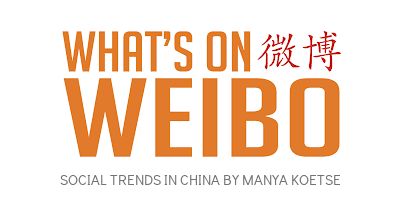
China Digital
“Dear Li Hua”: The TikTok/Xiaohongshu Honeymoon Explained
As American ‘TikTok Refugees’ flock to China’s Xiaohongshu (Rednote), their encounter with ‘Li Hua’ strikes a chord in divided times.
Published
4 days agoon
January 20, 2025
FROM THE WEIBO WATCH PREMIUM NEWSLETTER
China’s Xiaohongshu (Rednote) has seen an unprecedented influx of foreign “TikTok refugees” over the past week, giving rise to endless jokes. But behind this unexpected online migration lie some deeper themes—geopolitical tensions, a desire for cultural exchange, and the unexpected role of the fictional character Li Hua in bridging the divide.
Imagine you are Li Hua (李华), a Chinese senior high school student. You have a foreign friend, far away, in America. His name is John, and he has asked you for some insight into Chinese Spring Festival, for an upcoming essay has to write for the school newspaper. You need to write a reply to John, in which you explain more about the history of China’s New Year festival and the traditions surrounding its celebrations.
This is the kind of writing assignment many Chinese students have once encountered during their English writing exams in school during the Gaokao (高考), China’s National College Entrance Exams. The figure of ‘Li Hua’ has popped up on and off during these exams since at least 1995, when Li invited foreign friend ‘Peter’ to a picnic at Renmin Park.
Over the years, Li Hua has become somewhat of a cultural icon. A few months ago, Shangguan News (上观新闻) humorously speculated about his age, estimating that, since one exam mentioned his birth year as 1977, he should now be 47 years old—still a high school student, still helping foreign friends, and still introducing them to life in China.
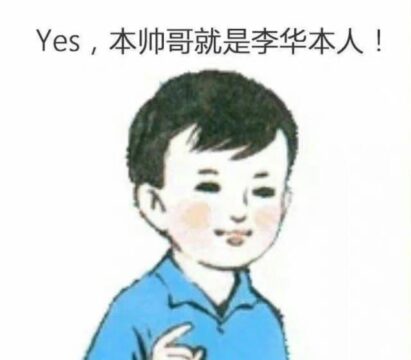
Li Hua: the connector, the helper, the icon.
This week, however, Li Hua unexpectedly became a trending topic on social media—in a week that was already full of surprises.
With a TikTok ban looming in the US (delayed after briefly taking effect on Sunday), millions of American TikTok users began migrating to other platforms this month. The most notable one was the Chinese social media app Xiaohongshu (now also known as Rednote), which saw a massive influx of so-called “TikTok refugees” (Tiktok难民). The surge propelled Xiaohongshu to the #1 spot in app stores across the US and beyond.
This influx of some three million foreigners marked an unprecedented moment for a domestic Chinese app, and Xiaohongshu’s sudden international popularity has brought both challenges and beautiful moments. Beyond the geopolitical tension between the US and China, Chinese and American internet users spontaneously found common ground, creating unique connections and finding new friends.
While the TikTok/Xiaohongshu “honeymoon” may seem like just a humorous trend, it also reflects deeper, more complex themes.
✳️ National Security Threat or Anti-Chinese Witchhunt?
At its core, the “TikTok refugee” trend has sprung from geopolitical tensions, rivalry, and mutual distrust between the US and China.
TikTok is a wildly popular AI-powered short video app by Chinese company ByteDance, which also runs Douyin, the Chinese counterpart of the international TikTok app. TikTok has over 170 million users in the US alone.
A potential TikTok ban was first proposed in 2020, amid escalating US-China tensions. President Trump initiated the move, citing security and data concerns. In 2024, the debate resurfaced in global headlines when President Biden signed the “Protecting Americans from Foreign Adversary Controlled Applications Act,” giving ByteDance nine months to divest TikTok or face a US ban.
TikTok, however, has continuously insisted it is apolitical, does not accept political promotion, and has no political agenda. Its Singaporean CEO Shou Zi Chew maintains that ByteDance is a private business and “not an agent of China or any other country.”
🇺🇸 From Washington’s perspective, TikTok is viewed as a national and personal security threat. Officials fear the app could be used to spread propaganda or misinformation on behalf of the Chinese Communist Party.
🇨🇳 Beijing, meanwhile, criticizes the ban as an act of “bullying,” accusing the US of protectionism and attempting to undermine China’s most successful internet companies. They argue that the ban reflects America’s inability to compete with the success of Chinese digital products, labeling the scrutiny around TikTok as a “witch hunt.”
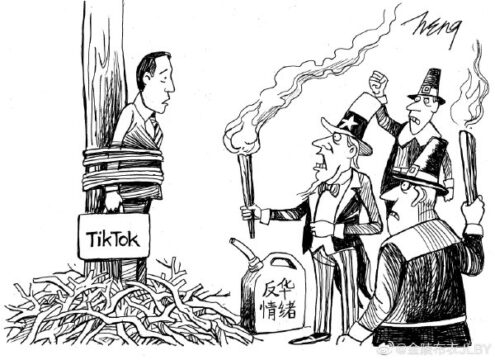
Political cartoon about the American “witchhunt” against TikTok, shared on Weibo in 2023, also published on Twitter by Lianhe Zaobao.
“This will eventually backfire on the US itself,” China’s Foreign Ministry spokesperson Wang Wenbin predicted in 2024.
Wang turned out to be quite right, in a way.
When it became clear in mid-January that the ban was likely to become a reality, American TikTok users grew increasingly frustrated and angry with their government. For many of these TikTok creators, the platform is not just a form of entertainment—it has become an essential part of their income. Some directly monetize their content through TikTok, while others use it to promote services or products, targeting audiences that other platforms like Facebook, Instagram, or X can no longer reach as effectively.
Initially, the mass migration of American users to Xiaohongshu was a symbolic protest against US policies. Users advocated for the right to choose their preferred social media, and voiced their frustration at how their favorite app had become a pawn in US-China geopolitical tensions. Rejecting the narrative that “data must be protected from the Chinese,” many pointed out that privacy concerns were equally valid for US-based platforms. As an act of playful political defiance, these users downloaded Xiaohongshu to demonstrate they didn’t fear the government’s warnings about Chinese data collection.
(If they had the option, by the way, they would have installed Douyin—the actual Chinese version of TikTok—but it is only available in Chinese app stores, whereas Xiaohongshu is accessible in international stores, so it was picked as ‘China’s version of TikTok.’)
Xiaohongshu is actually not the same as TikTok at all. Founded in 2013, Xiaohongshu (literal translation: Little Red Book) is a popular app with over 300 million users that combines lifestyle, travel, fashion, and cosmetics with e-commerce, user-generated content, and product reviews. Like TikTok, it offers personalized content recommendations and scrolling videos, but is otherwise different in types of engagement and being more text-based.
As a Chinese app primarily designed for a domestic audience, the sudden wave of foreign users caused significant disruption. Xiaohongshu must adhere to the guidelines of China’s Cyberspace Administration, which requires tight control over information flows. The unexpected influx of foreign users undoubtedly created challenges for the company, not only prompting them to implement translation tools but also recruiting English-speaking content moderators to manage the new streams of content. Foreigners addressing sensitive political issues soon found their accounts banned.
Of course, there is undeniable irony in Americans protesting government control by flocking to a Chinese app functioning within an internet system that is highly controlled by the government—a move that sparked quite some debate and criticism as well.
✳️ The Sino-American ‘Dear Li Hua’ Moment
While the initial hype around Xiaohongshu among TikTok users was political, the trend quickly shifted into a moment of cultural exchange. As American creators introduced themselves on the platform, Chinese users gave them a warm welcome, eager to practice their English and teach these foreign newcomers how to navigate the app.
Soon, discussions about language, culture, and societal differences between China and the US began to flourish. Before long, “TikTok refugees” and “Xiaohongshu natives” were collaborating on homework assignments, swapping recipes, and bonding through humor.
For instance, Chinese users jokingly asked the “TikTok refugees” to pay a “cat tax” for seeking refuge on their platform, which American users happily fulfilled by posting adorable cat photos. American users, in turn, joked about becoming best friends with their “Chinese spies,” playfully mocking their own government’s fears about Chinese data collection.

The newfound camaraderie sparked creativity, as users began generating humorous images celebrating the bond between American and Chinese netizens—like Ronald McDonald cooking with the Monkey King or the Terra Cotta Soldier embracing the Statue of Liberty. Later, some images even depicted the pair welcoming their first “baby.”

🇺🇸 At the same time, it became clear just how little Americans and Chinese truly know about each other. Many American users expressed surprise at the China they discovered through Xiaohongshu, which contrasted sharply with negative portrayals they’ve seen in the media. While some popular US narratives often paint Chinese citizens as “brainwashed” by their government, many TikTok users began to reflect on how their own perspectives had been shaped—or even “manipulated”—by their media and government.
🇨🇳 For Chinese users, the sudden interaction underscored their digital isolation. Over the past 15 years, China has developed its own tightly regulated digital ecosystem, with Western platforms like Facebook, Twitter, Instagram, and YouTube inaccessible in the mainland. While this system offers political and economic advantages, it has left many young Chinese people culturally hungry for direct interaction with foreigners—especially after years of reduced exchange caused by the pandemic, trade tensions, and bilateral estrangement. (Today, only some 1,100 American students are reportedly studying in China.)
The enthusiasm and eagerness displayed by American and Chinese Xiaohongshu users this week actually underscores the vacuum in cultural exchange between the two nations.
As a result of the Xiaohongshu migration, language-learning platform Duolingo reported a 216% rise in new US users learning Mandarin—a clear sign of growing interest in bridging the US-China divide.
Mourning the lack of intercultural communication and celebrating this unexpected moment of connection, Xiaohongshu users began jokingly asking Americans if they had ever received their “Li Hua letters.”
What started as some lighthearted remarks evolved into something much bigger as Chinese users dug up their old Gaokao exam papers and shared the letters they had written to their imaginary foreign friends years ago. These letters, often carefully stored in drawers or organizers, were posted with captions like, “Why didn’t you reply?” suggesting that Chinese students had been trying to reach out for years.

Example letters on Xiaohongshu: ‘Li Hua’ writing to foreign friends.
The story of ‘Li Hua’ and the replies he never received struck a chord with American Tiktok users. One user, Debrah.71, commented:
“It was the opposite for us in the USA. When I was in grade school, we did the same thing—we had foreign pen pals. But they did respond to our letters.”
Then, something extraordinary happened: Americans started replying to Li Hua.
One user, Douglas (@neonhotel), posted a heartfelt video of him writing a letter to Li Hua:
📝”Dear Li Hua, I’m sorry I didn’t get your letters. I understand you’ve been writing me for a long time, but now I’m here to reply. Hello, from your American friend. I hope you’re well. Life here is pretty normal—we go to work, hit the gym, eat dinner, watch TV. What about you? Please write back. I’m sorry I didn’t reply before, but I’m here now. Your friend, Douglas.”
Another user, Tess (@TessSaidThat), wrote:
📝”Dear Li Hua, I hope this letter finds you well. I’m so sorry my response is so late. My government never delivered your letters. Instead, they told me you didn’t want to be my friend. Now I know the truth, and I can’t wait to visit. Which city should I visit first? With love, Tess.”
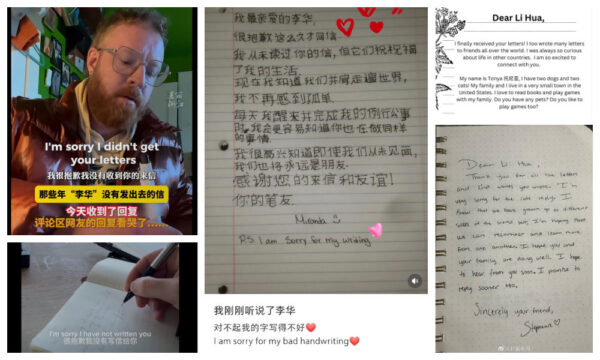
Examples of Dear Li Hua letters.
Other replies echoed similar sentiments:
📝”Dear Li Hua, I’m sorry the world kept us apart.”
📝”I know we don’t speak the same language, but I understand you clearly. Your warmth and genuine kindness transcend every barrier.”
📝”Did you achieve your dreams? Are you still practicing English? We’re older now, but wherever we are, happiness is what matters most.”
These exchanges left hundreds of users—both Chinese and American, young and old, male and female—teary-eyed. In a way, it’s the emotional weight of the distance—represented by millions of unanswered letters—that resonated deeply with both “TikTok refugees” and “Xiaohongshu natives.”

Emotional responses to the Li Hua letters.
The letters seemed to symbolize the gap that has long separated Chinese and American people, and the replies highlighted the unusual circumstances that brought these two online communities together. This moment of genuine cultural exchange made many realize how anti-Chinese, anti-American sentiments have dominated narratives for years, fostering misunderstandings.

Xiaohongshu commenter.
On the Chinese side, many people expressed how emotional it was to see Li Hua’s letters finally receiving replies. Writing these letters had been a collective experience for generations of Chinese students, creating messages to imaginary foreign friends they never expected to meet.
Receiving a reply wasn’t just about connection; it was about being truly seen at a time when Chinese people often feel underrepresented or mischaracterized in global contexts. Some users even called the replies to the Li Hua letters a “historical moment.”
✳️ Unity in a Time of Digital Divide
Alongside its political and cultural dimensions, the TikTok/Xiaohongshu “honeymoon” also reveals much about China and its digital environment. The fact that TikTok, a product of a Chinese company, has had such a profound impact on the American online landscape—and that American users are now flocking to another Chinese app—showcases the strength of Chinese digital products and the growing “de-westernization” of social media.
Of course, in Chinese official media discourse, this aspect of the story has been positively highlighted. Chinese state media portrays the migration of US TikTok users to Xiaohongshu as a victory for China: not only does it emphasize China’s role as a digital superpower and supposed geopolitical “connector” amidst US-China tensions, but it also serves as a way of mocking US authorities for the “witch hunt” against TikTok, suggesting that their actions have ultimately backfired—a win-win for China.
The Chinese Communist Party’s Publicity Department even made a tongue-in-cheek remark about Xiaohongshu’s sudden popularity among foreign users. The Weibo account of the propaganda app Study Xi, Strong Country, dedicated to promote Party history and Xi Jinping’s work, playfully suggested that if Americans are using a Chinese social media app today, they might be studying Xi Jinping Thought tomorrow, writing: “We warmly invite all friends, foreign and Chinese, new and old, to download the ‘Big Red Book’ app so we can study and make progress together!”
Perhaps the most positive takeaway from the TikTok/Xiaohongshu trend—regardless of how many American users remain on the app now that the TikTok ban has been delayed—is that it demonstrates the power of digital platforms to create new, transnational communities. It’s unfortunate that censorship, a TikTok ban, and the fragmentation of global social media triggered this moment, but it has opened a rare opportunity to build bridges across countries and platforms.
The “Dear Li Hua” letters are not just personal exchanges; they are part of a larger movement where digital tools are reshaping how people form relationships and challenge preconceived notions of others outside geopolitical contexts. Most importantly, it has shown Chinese and American social media users how confined they’ve been to their own bubbles, isolated on their own islands. An AI-powered social media app in the digital era became the unexpected medium for them to share kind words, have a laugh, exchange letters, and see each other for what they truly are: just humans.
As millions of Americans flock back to TikTok today, things will not be the same as before. They now know they have a friend in China called Li Hua.
By Manya Koetse
(follow on X, LinkedIn, or Instagram)
Spotted a mistake or want to add something? Please let us know in comments below or email us. First-time commenters, please be patient – we will have to manually approve your comment before it appears.
©2025 Whatsonweibo. All rights reserved. Do not reproduce our content without permission – you can contact us at info@whatsonweibo.com.
China Insight
Story of Chinese Female MA Graduate Going Missing for 13 Years Sparks Online Storm
The story of the Chinese MA graduate, Ms. Bu, who disappeared in 2011 brings back memories of the Xuzhou mother of eight, who was later revealed to be a victim of human trafficking.
Published
1 month agoon
December 10, 2024
Once a promising Master’s graduate in Engineering, Ms. Bu went missing for 13.5 years. Her return marks the end of her family’s long search, but it is the beginning of an online movement. Chinese netizens are not only demanding answers about how she could have remained missing for so long but also want clarity about the puzzling inconsistencies in her story.
Over the past few days, Chinese social media users have been actively spreading awareness about a case involving a Chinese woman who they suspect became a victim of human trafficking.
Netizens trying to draw attention to this story used the hashtag “Female MA Graduate Becomes a Victim of Human Trafficking” (#女硕士被拐卖#). Between December 6 and December 10, the hashtag garnered 150 million views on Weibo.
The case centers on a Chinese female Master’s graduate from Yuxi District in Shanxi Province’s Jinzhong, who went missing for over thirteen years. Now reunited with her family, netizens are demanding clarity and answers about how she could have disappeared for so long.
This case, which has sparked emotional and outraged responses online, brings back memories of another incident that became a landmark moment for online feminism in China: the case of the Xuzhou mother of eight children, who was discovered chained in a shed next to her family home. Her husband was later sentenced to nine years in prison for his role in her human trafficking.
A Niece’s Search into the Origins of Her Mysterious Aunt
The online movement to raise awareness about this case began well before it gained traction on December 6. It all started when a young woman named Zhang (张) from He Shun County (和顺县) contacted a volunteer group dedicated to reuniting missing individuals. On November 25 of this year, Zhang sought their help in tracking down the family of her somewhat mysterious “aunt.”
According to Zhang, her aunt—who suffered from mental illness—had been living with her uncle for over a decade. Despite this long history, the family knew almost nothing about her past. Wanting to know more, Zhang reached out to the group in hopes of learning about her aunt’s origins.
Zhang claimed that her “aunt” had wandered into their family home one day fifteen years ago. Although they reportedly informed the police, no action was taken, and they allegedly decided to “take her in.” After about two years, she ended up living with Zhang’s uncle, with whom she had two children.
When volunteers visited the family home, they found that the “aunt” was literate and appeared to be well-educated. As reported by the popular WeChat account Xinwenge (December 4 article), the volunteers gradually guided the woman into revealing her name, her family members’ names, and the university she attended.
After passing this information to the police, they confirmed her identity as ‘Ms. Bu’ (卜女士), a missing person from Jinzhong’s Yuxi, about a 2.5-hour drive from He Shun County.
On November 30, Ms. Bu finally returned home, where her 75-year-old father had prepared a welcome banner for her. She was accompanied by her “husband” and their two children, a 12-year-old son and an 8-year-old daughter.

A banner in Jinzhong’s Yuxi: “Welcome home, daughter.”
Although Bu initially did not seem to recognize her father, Chinese media reported that she eventually smiled when he brought out her glasses, which she had worn as a student.
From Doctorate Pursuit to Disappearance
Ms. Bu was born in 1979. As a bright young woman, she graduated high school, attended college, and earned her master’s degree in engineering in 2008. Bu planned to pursue a doctorate afterward. However, due to not renewing her ID card in time, she failed to register for her doctoral exam.
This caused severe stress, and she subsequently developed schizophrenia. Her brother recalled that it was not the first time she had struggled with mental health issues—she had undergone various treatments at multiple hospitals for mental illness between 2008 and 2011.
At the time, Bu reportedly received medical treatment. While recovering at home after being discharged, the then 32-year-old Bu suddenly disappeared in May 2011. Although she was reported as a missing person, her family did not hear from her for over 13 years.
But this is where the questions arise. According to Ms. Zhang, her “aunt” had first walked into their home fifteen years ago, which is impossible since Bu did not go missing until May 2011.
Other aspects of Bu’s disappearance also raise questions. How did she end up in He Shun County? Why did the Zhang family not seek help all these years? And how was she able to have two children with her “husband” despite her fragile mental state?
Authorities Get Involved
While the story of Ms. Bu has received considerable online attention over the past few days, a joint investigation team was set up in Shanxi’s He Shun County to investigate the case. While investigations are still ongoing, new reports suggest that, after her disappearance in May 2011, Bu spent some time wandering alone in multiple nearby villages for over ten days in July and August of that year, exhibiting signs of mental illness.
She was later taken in by Mr. Zhang, a 45-year-old villager, who is now the target of an active criminal investigation. Zhang was aware of Ms. Bu’s mental condition yet engaged in relations with her, resulting in children.
Bu has now been hospitalized for treatment, and authorities are providing support to her children. It is unclear if they will remain with their father—custody arrangements will be determined based on the outcome of the case.
On social media, interest in the case is only growing. On Tuesday, a Xinhua post detailing the latest updates on the case received over 433,000 likes and 44,000 shares shortly after it was posted.
Despite the official updates, questions continue to surround the case of Ms. Bu, nicknamed ‘Hua Hua’ (花花). Given that her mental illness was apparent to so many, why did local authorities fail to intervene earlier? Particularly during the strict social controls and widespread testing of China’s ‘zero-Covid’ era, it is hard to believe that local authorities were unaware of her existence and her mental state. These criticisms and questions are flooding social media and growing louder as more details about her past emerge.
Ms. Zhang, the family niece, further revealed in a livestream that ‘Hua Hua,’ who was reportedly sleeping under a bridge before being taken in by the Zhang family, actually had more than two children. However, as of the time of writing, the fate of these additional children remains unclear.
This case also brings back memories of the Xuzhou mother of eight, another victim of mental illness who was nonetheless “married” to her “husband” and gave birth to eight children. Her story sparked a massive online outcry over how local authorities were complicit in enabling such abuses.
“From the Xuzhou chained woman to the missing Ms. Bu, these women’s tragedies cannot remain incomplete stories,” author Ma Ning (麻宁) wrote on Weibo. “Women are not commodities for marriage and reproduction (…) Let’s continue to follow this case, not just to seek justice for Ms. Bu but also to protect ourselves.”
See more about this story in our follow-up article here.
By Manya Koetse, with contributions by Miranda Barnes
(follow on X, LinkedIn, or Instagram)
Spotted a mistake or want to add something? Please let us know in comments below or email us. First-time commenters, please be patient – we will have to manually approve your comment before it appears.
©2024 Whatsonweibo. All rights reserved. Do not reproduce our content without permission – you can contact us at info@whatsonweibo.com.
What’s on Weibo Chapters
Subscribe

“Black Myth: Wukong”: From Gaming Screens to the CMG Spring Festival Gala?

“Dear Li Hua”: The TikTok/Xiaohongshu Honeymoon Explained

TikTok Refugees, Xiaohongshu, and the Letters from Li Hua

15 Years of Weibo: The Evolution of China’s Social Media Giant

Introducing What’s on Weibo Chapters

The Price of Writing Smut: Inside China’s Crackdown on Erotic Fiction

Controversial Wanghong Livestreamers Are Becoming a Weibo Staple in China

Weibo Watch: “Comrade Trump Returns to the Palace”

The ‘Cycling to Kaifeng’ Trend: How It Started, How It’s Going

Hu Xijin’s Comeback to Weibo

Our Picks: Top 10 Chinese Buzzwords and Phrases of 2024 Explained

The Viral Bao’an: How a Xiaoxitian Security Guard Became Famous Over a Pay Raise

Why Chinese Hit Movie “Her Story” is ‘Good Stuff’: Stirring Controversy and Celebrating Female Perspectives

Chiung Yao’s Suicide Farewell Letter: An English Translation

12-Year-Old Girl from Shandong Gets Infected with HPV: Viral Case Exposes Failures in Protecting Minors
Get in touch
Would you like to become a contributor, or do you have any tips or suggestions? Get in touch here!
Popular Reads
-

 China Insight9 months ago
China Insight9 months agoThe Tragic Story of “Fat Cat”: How a Chinese Gamer’s Suicide Went Viral
-

 China Music10 months ago
China Music10 months agoThe Chinese Viral TikTok Song Explained (No, It’s Not About Samsung)
-
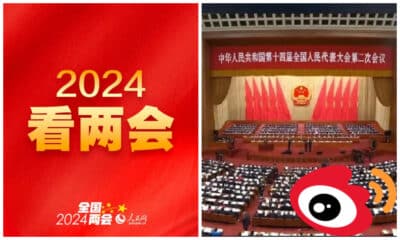
 China Insight11 months ago
China Insight11 months agoThe ‘Two Sessions’ Suggestions: Six Proposals Raising Online Discussions
-

 China Digital8 months ago
China Digital8 months agoChina’s 2024 Gaokao Triggers Online Discussions on AI
